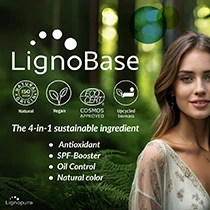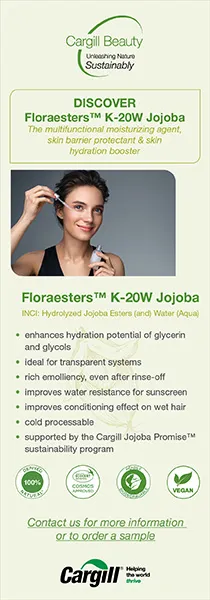Biodegradable and microplastic-free polymers for styling, skin care and makeup

10 Oct 2023 --- The cosmetics industry is experiencing an eco-conscious shift to accompany beauty and styling products trying to care for the planet, and not at the expense of it. Cosmetic polymers are found in liquid, solid or wax textures, and Personal Care Insights speaks to Solvay about their biodegradable and nature-sourcing solutions. We also look at recent research by L’Oréal and the University of Mons, Belgium, who present an environmentally friendly alternative to silicon-based film formers.
“Polymers have long been recognized as leading rheology modifiers, giving formulators unmatched control over the viscosity and texture of advanced beauty formulations while ensuring long-term on-shelf product stability. They are also widely known as conditioning agents, optimized to deliver wet and dry hair conditioning benefits, especially in silicone-free shampoos,” Margot Bon, research and innovation project manager at Solvay, tells us.
“It should come as no surprise to learn that polymers also raise the performance bar in styling applications. In today’s vibrant styling market, there are two distinct categories: chemical styling and physical styling. Polymers belong to the physical styling category as they form a film on the hair, acting as a humidity shield and a mechanical frame on the hair surface.”
She explains that polymers enable styling benefits such as straightening curly hair, protecting against frizz, creating curls for consumers with straight hair or improving the definition of naturally curly hair.
Biodegradable and natural solutions in demand
Bon observes that most styling solutions on the market are synthetic. “However, consumers are becoming increasingly conscious of the impact that their everyday routines have on the environment and are increasingly looking for performance without harming the planet.” Solvay takes a “biodegradable by design” approach during innovation (Image credit: Solvay).
Solvay takes a “biodegradable by design” approach during innovation (Image credit: Solvay).
“This means the beauty industry must rapidly sustain a green chemistry transformation making biodegradability, which does not come at the expense of performance, one of the most pressing challenges to address,” she says.
Based on Solvay’s recent launch Naternal, Bon explains how the product offers biodegradable and naturally sourced polymers from guar plants.
Bon clarifies that natural beauty does not necessarily mean hard styling, such as fixative gel, it can also be soft “with the absence of flakes, residues, stickiness or dullness” without changing the aesthetic or sensory properties.
“In addition, Solvay prefers to adopt a ‘multi’ approach to product development, providing multi-functional ingredients. The result is the development of polymers for styling benefits that not only help to discipline hair but will also bring other properties such as conditioning to help with de-tangling, for example, or film-forming properties to improve hair softness,” highlights Bon.
No compromise on performance
Bon shares that consumers are aware of the consequences of their consumption behaviors on the planet, however, they are not willing to compromise on the efficacy of the products they use.
“Consequently, our new launches will result from a ‘biodegradable by design’ approach without compromising performance. So, to be aligned with these needs and the dynamic mode of living of today’s consumers, we are currently working on a series of projects that increase the persistence and resistance of products to minimize the consumption and the amount of product used.”  Solvay is an expert in naturally-derived polymers for beauty care formulations.
Solvay is an expert in naturally-derived polymers for beauty care formulations.
The “biodegradable by design” approach is applied starting from the early stages of innovation projects to ensure a new ingredient will be biodegradable. Solvay aims to design products that can provide long-lasting benefits and efficient products that can resist shampoos.
“There is also a rising demand for modern and smart solutions with a clean environmental profile. Therefore, we are developing Naternal to provide solutions customized for all types of hair, from all ethnicities and for all levels of damage,” notes Bon.
Personal Care Insights has also interviewed Bon on Solvay’s “biodegradable by design” polymers for future hair care products.
New eco-friendly alternative to silicones
Furthermore, research by L’Oréal and the University of Mons flag that silicon-based (a polymer) film-formers used in skin care and makeup are environmentally concerning.
As an environmentally sustainable alternative, they spotlight versatile acrylate polymers, which “create durable films with wear resistance, color stability and adaptability to various conditions.”
“Acrylate copolymers deposited on dry human stratum corneum significantly improved surface roughness. Furthermore, our results demonstrate that the miscible capacity is enhanced under heated and moist conditions, accompanied by a dramatic decrease in stiffness,” write the authors.
“This indicates that acrylic copolymers can form a thin, soft, adhesive layer on human skin, even in the presence of perspiration and sebum. These findings suggest the potential use of acrylic copolymers as model systems for next-generation cosmetic bio-sourced materials.”
The complex case of microplastics
Alternatives to specific synthetic polymers come at a time when the EU recently banned intentionally added microplastics to products under the EU chemical legislation REACH Regulation (Registration, Evaluation, Authorisation and Restriction of Chemicals). L’Oréal Research and Innovation and University of Mons present acrylate polymers as an environmentally sustainable alternative to silicone-based film formers.
L’Oréal Research and Innovation and University of Mons present acrylate polymers as an environmentally sustainable alternative to silicone-based film formers.
According to the EU Chemicals Agency, microplastics are solid-state synthetic microparticles with insoluble, non-biodegradable polymers smaller than 5 mm.
However, L’Oréal clarifies a distinction between polymers and microplastics: “All microplastics are polymers, but not all polymers are microplastics.”
“For example, with polytetrafluoroethylene and polyethylene (PE). For the latter, we use a highly malleable PE wax in the case of lipsticks. During formulation, the raw materials are mixed at over 90°C, the PE melts completely and we obtain an even mix of all the ingredients.”
As a result, there are no solid PE particles in L’Oréal’s lipsticks as they all melted. “This (liquid) wax has no microplastic,” yet it is indicated on the ingredients list with its INCI (International Nomenclature of Cosmetic Ingredients) name: PE.
“The INCI classification and nomenclature featuring in the ingredients list displayed on the packaging is not sufficient for determining whether an ingredient is a microplastic,” states L’Oréal.
Furthermore, not all polymers are chemical-based, as they are also found in nature, such as silk, wool, proteins, DNA and corn starch.
“Only a few polymers are biodegradable, but their impact on the environment depends mainly on the length of their chains. Our teams have always tried to find polymers that are of natural origin and biodegradable,” shares L’Oréal.
By Venya Patel












